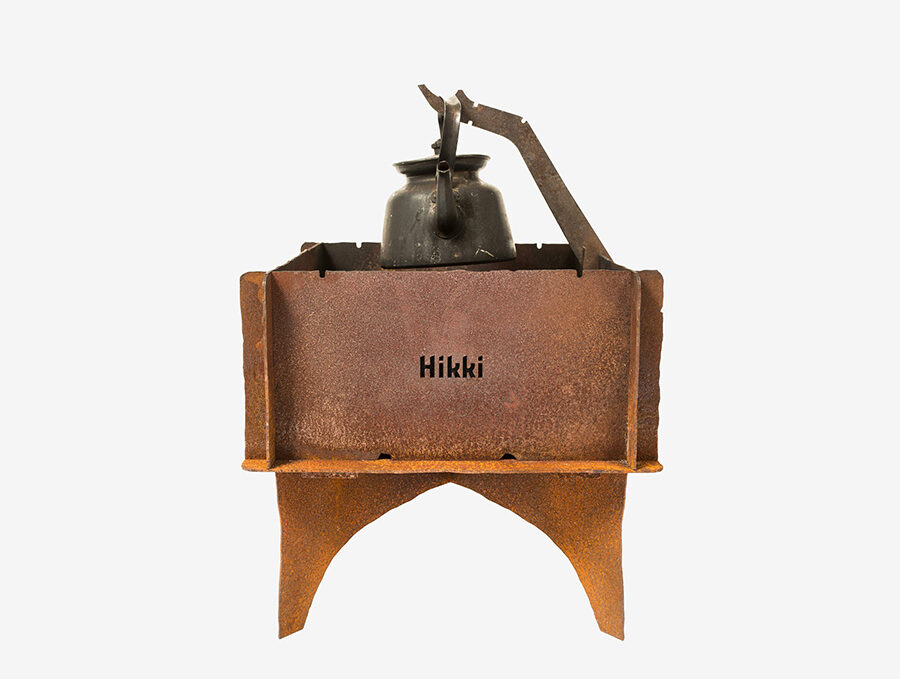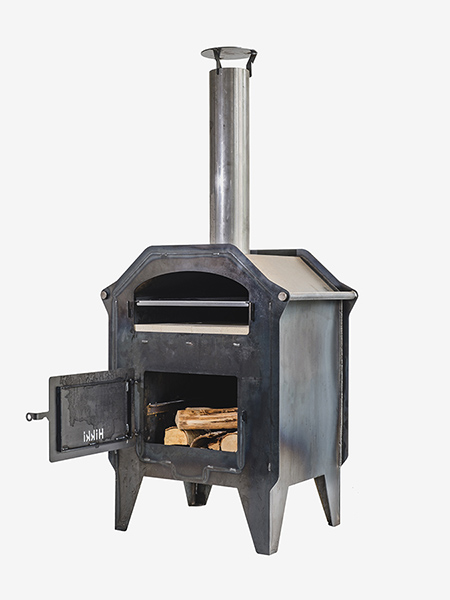Akenberg meets
Per Enoksson
He has made a name for himself with his sweat lodge, outdoor bathtub and wood-fired stove. Now the internationally acclaimed designer and visual artist Per Enoksson behind the brand Hikki takes the next steps in his quest to convey something new to the world.
With roots in the Sami culture, Per grew up with unlimited access to material and knowledge about handicraft. Learning to craft knifes and other Sami everyday use objects out of leather and reindeer horn at young age, he has now created his own portfolio of carefully selected products gravitating between living, cooking and clothing. All in small but exclusive series not compromising on utility, robustness or details. Simply design that is made to last a lifetime.
Currently based in Tärnafjällen, living with his family in a cottage close to a big lake, Per has like many self-made entrepreneurs been affected by the corona crisis and its effects. Yet, he believes that this “suspended time” offers us a great opportunity to take a step forward in creating a truly sustainable world – and also be transformed into new innovative ideas and opportunities.
– I often think about how to solve new situations like this one for people to find an enriching everyday life in their home environment. If one can formulate the most essential in the shape of a product or service, what would it be? I guess millions of entrepreneurs around the world are thinking the same thing right now. It will be interesting to see in ten years how the corona crisis changed our lifestyle and our values.
What projects are you involved in right now?
– I’m in the final stages of fine-tuning our portfolio for a project that a New York-based architectural firm has shown interest in. I hope to be able to pick up that thread again as things settle down after the corona crisis. I also work with the marketing details surrounding the launch of a new product, a cooking product made to gather around. Thirdly, I´m sketching up public art project for a pre-school.

When did you know you wanted to be a designer and work with handicraft?
– I went to an art school when I had just turned 20, but already in my early teens I dreamt about making and selling my own products. I used to have a summer job weaving ribbons and making keychains that we sold during the season. For me as a child, there was something fascinating about being able to make my own money on home-made things.
In what way has your upbringing influenced your career choice?
– I have a Sami background and my parents are both Sami artisans, so throughout my upbringing I learned everything from collecting material to creating crafts in both wood and textile. Our home was welcoming and we always had a lot of creative people visiting and who inspired me to create. That was probably a contributing reason to why I chose to become a visual artist. After studying at the art colleges in Oslo, Stockholm and Umeå, I worked as an artist for 15 years before I started Hikki and began working on product development. As an artist, you have to be persistent, a trait that is good to have as an entrepreneur. Building a brand takes time.

Describe your working process!
– When designing for Hikki, the process always starts by me scanning the world for everything that may be relevant to the brand. There may be articles in the daily press, or something interesting about technology on the web, as well as an exhibition on crafts or art. If I have a vague idea of what kind of art or design I want to do, I can flesh out an idea by exposing myself to a large flow of impressions.
Which part of your process is the most important one and why?
– When I’m forced to take a decision and execute the idea. Currently, I have around 10-15 product ideas that I have worked with in theory for a long time. I love working with 3D models in my head; to remove and add details exactly how you want. I test for a long time how function and aesthetics work before I start sketching on paper. Unfortunately, I can’t work with 3D software, but I still can envision how the product should be made. Once I have managed to produce a usable sketch on paper, my colleague Andreas will be able to convert it into production-ready material.
How would you define your aesthetics?
– We make products inspired by the barren nature as well as the colourful urban life. Extremes that together create a new way of being, living and relaxing.

What inspires you?
– Right now, I’m mainly studying Sami architectural traditions and thinking about how and why they made certain construction engineering solutions, like the shape and the function of the hut. If I’m travelling to a big city, I always go to museums and exhibitions of different kinds. I especially like art by people who are not always educated artists. Those who paint, make handicraft, buildings and other things just because they “have to”.
You are very productive, where do you get your energy?
– The late winter is the absolutely loveliest up here in the fjelds. Just lying down on a reindeer skin by a fire, carving with my knife on a piece of dried reindeer meet, and possibly be lucky enough to catch a char ice-fishing – such an experience can fulfill me for a long, long time.
What is your view on sustainability?
– I want to create products that are sustainable, literally. They have to be easily repairable, and the materials should be easy to separate for recycling. The absolutely best, from an environmental point of view, would of course be if all products on the planet could enter into an endless circulation like nature itself. Imagine if you by that also could solve the global energy issue … A utopian thought, but there is hope and we must continue striving towards that vision and focus on what we can here and now.


You have a great personal style! What is the last item of clothing you added to your wardrobe?
– A navy blue corduroy suit. I had planned to wear it when I was in New York earlier this year. But unfortunately, it never came into use there. And here at home in our cottage, I mostly walk around in my comfortable merino wool underwear.
Which Instagram profiles or blogs do you follow?
– If I should name one it has to be Bolt Threads on Instagram. I’m inspired by different kinds of material, and especially new material, such as sustainable fashion biomaterials. For instance, their microsilk has been developed after studies of spiders’ ability to spin thread, which is amazingly cool.
So, what do you know about cellulose and bio acetate?
– Actually, I’m not familiar with the material itself and only know it by its designation. But it’s so great that you use a fully sustainable material in your frames, and I think that all new types of biomaterials are very interesting.
Your favourite frame from Akenberg?
– Definitely Suobbat in colourway Upstream dream. When I put them on, I get a spontaneous ”wow” from my wife!



